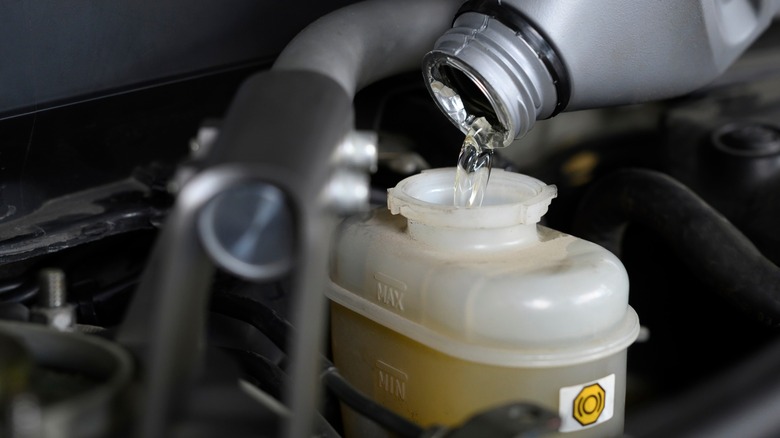What Color Is Brake Fluid? What To Look For In A Leak
Unlike the elusive and oft-memed blinker fluid, brake fluid actually exists. Even more than that, it's one of the more important components of vehicular safety. As the name implies, it's a fluid that works directly with your brakes, but it's more than a lubricant. Brake fluid plays a crucial role in a car's ability to stop, and the entire hydraulic braking system wouldn't work without it. So, if you thought there were only five fluids to check (engine oil, transmission fluid, coolant, power steering fluid, and gear oil), you're missing a sixth that could be life-saving.
Checking brake fluid isn't just about ensuring the levels are good. Brake fluid should also have a very distinct color. If it's discolored in any way, that could be an indicator of contaminates that will hinder the fluid's ability to act as a hydraulic. It could also reduce the absorbent properties of the fluid, which is needed to reduce the presence of water and prevent corrosion in brake components like fluid lines and calipers.
Typically, new and clean brake fluid is a clear yellow or amber, almost like an unused light olive oil. However, that's not universal across all types and vehicles. There are several different classifications of brake fluid, some made for different applications such as performance vehicles and others used simply at the discretion of the manufacturer.
Identifying the color of your car's brake fluid
If you're driving around in a standard Toyota or a Ford, chances are you're good to go with the yellowish brake fluid. This is a DOT 3 fluid, which is a classification provided by the Department of Transportation. There are three primary classifications of brake fluid assigned by the DOT. For the purpose of identifying which fluid your vehicle uses, the colors are a fairly good indicator, though not foolproof. DOT 3, for example, may also present in shades of green, blue, or red. DOT 4, which is a longer-lasting variety, is available in a yellow or deep red color. Available for more niche applications, DOT 5 and DOT 5.1 fluids are often found in purple or blue, clear, and yellow, respectively.
Since there is some overlap, particularly when it comes to yellow brake fluids, you may not feel entirely comfortable relying on shade. Thankfully, you shouldn't have to. The car's owner's manual should list the recommended fluid classification. If you don't have that, you'll need to pop the hood and check the brake fluid reservoir cap. This is not the case for every vehicle, but the classification is sometimes printed on the cap itself. Since mixing fluids can damage your brake components and pose a safety risk, if you have any doubts, always check with a mechanic.
For all of the classifications, if they start to look darker than their original color, it's time for a flush and replacement.
How to tell if you have a brake fluid leak?
Considering how important brake fluid is, you'll always want it to be on the up and up. Like any other fluid on a car, though, brake fluid can leak. Sometimes, you'll spot the leak when you see a puddle of amber liquid forming under your car or if the brake warning light glows on the dashboard. If the leak is slower and less severe, that puddle may not be there and the indicator may not light up. In this instance, you'll need to really pay attention to what your car is telling you. Even a slow trickling leak can be dangerous when left unrepaired.
The signs of a leak are fairly simple to spot. One of the most telling is if you're pressing your brake pedal and it hits the floor with ease. Remember, it's the fluid that causes the brake pad to engage and slow the car down. You should feel a decent degree of resistance every time your foot comes down on the pedal. Another indication you may have a leak is if the brake pedal feels spongy or too soft.
You may not be able to prevent a leak from ever happening, but you can take some precautions to prolong your braking system. Most importantly, keep your fluid levels optimal. If they get too low, the brake line can corrode. You should also immediately address any changes to how the car brakes and always follow the manufacturer-recommended maintenance schedule.


